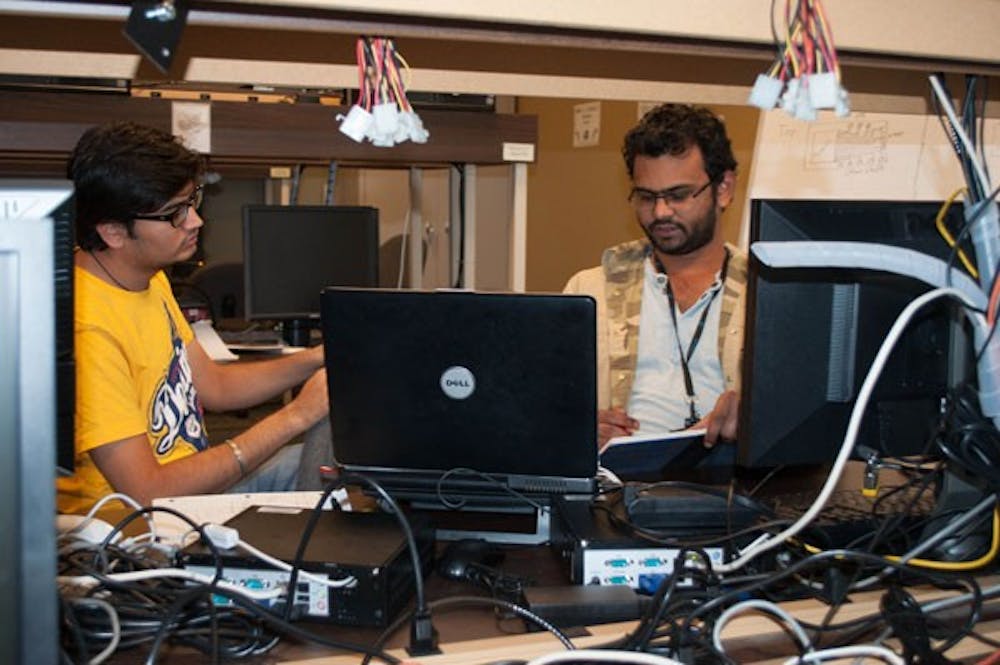 Imtiyaz Hussain and Koshik Samoth, both computer science graduate students, work on a group project in the engineering lab of the Ira A. Fulton Schools of Engineering on the Tempe campus on Sunday afternoon. The engineering program is currently focusing on getting its first-year students more experience to better prepare them for the work force after graduation. (Photo by Danielle Gregory)
Imtiyaz Hussain and Koshik Samoth, both computer science graduate students, work on a group project in the engineering lab of the Ira A. Fulton Schools of Engineering on the Tempe campus on Sunday afternoon. The engineering program is currently focusing on getting its first-year students more experience to better prepare them for the work force after graduation. (Photo by Danielle Gregory)Ira A. Fulton Schools of Engineering deans revamped the freshmen learning experience by changing their philosophy to include first-year students as active engineers.
Dean Paul Johnson and Associate Dean of Academic and Student Affairs James Collefello, who have worked together for the past five years to construct a program that promotes practical experience for all engineering students, developed the “engineers from day one” idea.
This year’s focus is to incorporate hands-on learning experiences for first-year students before they take applied courses such as physics and calculus.
“To us, if a student enrolls in engineering as a freshman, we want them engaged in engineering right away,” Johnson said.
To ensure this happens, the deans collaborated to redesign the programs to guarantee student participation during all four years.
Collefello said this was designed so students stay interested in engineering.
“If (the students) don’t see engineering, then they may lose the enthusiasm for it and may drift off to other majors,” Collefello said. “We like them to get engaged and feel the excitement about engineering.”
The deans decided to integrate this idea with their classroom work by creating the eSpace, a laboratory filled with tools to excite students and give them hands-on experience through projects.
Half of the curriculum is classroom learning, and the other half is experimental learning, Johnson said.
“We wanted to stay away from the typical engineering programs,” Johnson said. “We want our programs … and students to be unique.”
A typical engineering program shies away from welcoming first- and second-year students as engineers and embraces the students their junior year, Johnson said.
Early curriculums would be filled with math and physics, and occasional engineering classes offer little engagement with the engineering program, Johnson said.
“Most of the learning is classroom-centric,” Johnson said. “It is basically a sequence of courses to satisfy degree requirements, and you graduate.”
He said they disagree with this traditional method and have integrated social experiments into the program for the past five years. They developed engineering degree programs as a “series of one-year experiences,” Johnson said.
With the new approach, Johnson and Collefello increased the opportunities for each level of students.
School spokesman Joe Kullman said the Fulton staff focuses on students more than other engineering schools do.
“Entrepreneurship, teamwork and collaboration are the main things that we want to see students get involved in beyond just the classroom,” Kullman said.
The deans said these experiences make Fulton students more prepared for anything they do outside of ASU.
Next year’s goal is to build more infrastructures to support student organizations where the students can exercise their creativity and build their skill sets, Johnson said.
Collefello said though having strong students has always been important, engaging the students and making the engineering programs as strong as possible from the student side became a priority five years ago when new leadership in the dean’s office was brought in.
“We feel that we owe it to them,” Collefello said.
Reach the reporter at bmlawso2@asu.edu and on Twitter @brookeml




